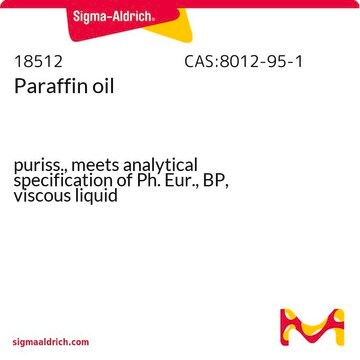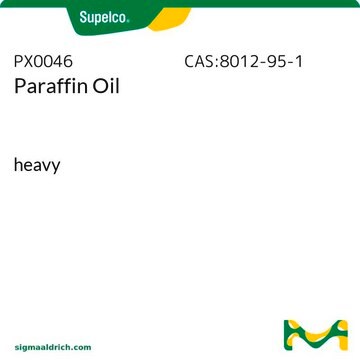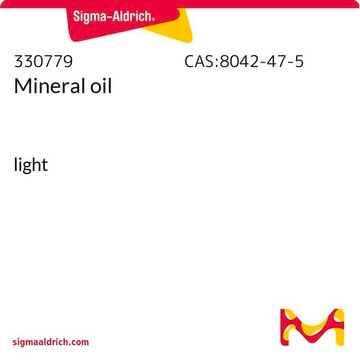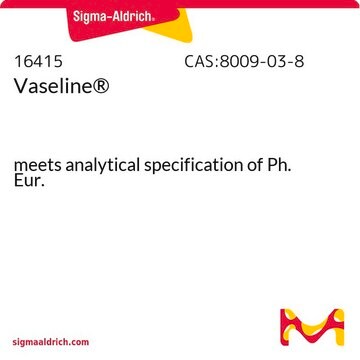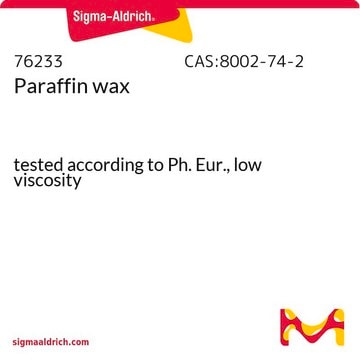Recommended Products
form
oil
Quality Level
technique(s)
IR spectroscopy: suitable
refractive index
n20/D 1.473
viscosity
100-145 mPa.s(20 °C)
bp
300 °C (lit.)
mp
-24 °C (lit.)
Looking for similar products? Visit Product Comparison Guide
General description
Paraffin oil resists water. It is widely used as release agent, lubricant, defoamer and also as coating component.
Application
Paraffin oil has been used in preparation of tyrosinase-modified carbon paste electrode for detection of Catechol.
Signal Word
Danger
Hazard Statements
Precautionary Statements
Hazard Classifications
Asp. Tox. 1
Storage Class Code
10 - Combustible liquids
WGK
WGK 2
Flash Point(F)
419.0 °F - closed cup
Flash Point(C)
215 °C - closed cup
Personal Protective Equipment
dust mask type N95 (US), Eyeshields, Gloves
Choose from one of the most recent versions:
Already Own This Product?
Find documentation for the products that you have recently purchased in the Document Library.
Customers Also Viewed
Rate-limiting steps of tyrosinase-modified electrodes for the detection of catechol.
Burestedt E
Analytical Chemistry, 68(9), 1605-1611 (1996)
Eryn Slankster et al.
Scientific reports, 10(1), 3119-3119 (2020-02-23)
Starvation enhances olfactory sensitivity that encourage animals to search for food. The molecular mechanisms that enable sensory neurons to remain flexible and adapt to a particular internal state remain poorly understood. Here, we study the roles of GABA and insulin
Wenming Wu et al.
The Analyst, 136(11), 2287-2293 (2011-04-05)
Bubble formation inside a microscale channel is a significant problem in general microfluidic experiments. The problem becomes especially crucial when performing a polymerase chain reaction (PCR) on a chip which is subject to repetitive temperature changes. In this paper, we
Yi-Shiung Horng et al.
American journal of physical medicine & rehabilitation, 90(6), 435-442 (2011-03-25)
: The aim of this study was to investigate the effectiveness of tendon and nerve gliding exercises as a part of combined treatments for carpal tunnel syndrome. : Patients with carpal tunnel syndrome were randomized into three groups. All patients
Jyothi C Abbar et al.
Bioelectrochemistry (Amsterdam, Netherlands), 83, 1-7 (2011-07-26)
The electrochemical oxidation of a hemorheologic drug, pentoxifylline was investigated at a multi-walled carbon nanotubes-paraffin oil paste electrode using cyclic and differential pulse voltammetry. The oxidation process was irreversible over the pH range studied and exhibited an adsorption-controlled behavior. All
Our team of scientists has experience in all areas of research including Life Science, Material Science, Chemical Synthesis, Chromatography, Analytical and many others.
Contact Technical Service